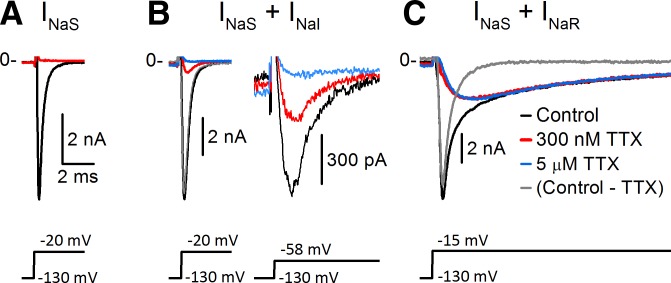Fig. 2.
Pharmacological dissection with tetrodotoxin (TTX) revealed 3 types of Na+ current composition in vestibular ganglion neurons (VGNs), as shown by these representative examples. Legend in C applies to A–C. Recording solutions in this and all subsequent figures were Cs+ internal and Cs+ external (Table 1) unless otherwise specified; channel blockers were added to the external solution. VH = −70 mV in all figures. Voltage was first stepped to −130 mV to de-inactivate INaV, then stepped to a depolarized value. All currents are shown on the same time scale, but amplitude has been scaled for display. Transient capacitive artifact at the voltage step was truncated in this and subsequent figures. A: INaV was completely blocked by 300 nM TTX in some VGNs, indicating that it was entirely TTX sensitive (INaS). Data are from P3 VGN. B: some VGNs expressed a mixture of INaS and a more negatively activating TTX-insensitive current (INaI). INaI was small relative to total INaV for a step to −20 mV (left) but more prominent for a step to −58 mV (right, expanded current scale) because it activated at more negative voltages. Data are from P2 VGN. C: other VGNs had a mixture of INaS and a slower, more positively activating TTX-resistant current (INaR). Note that the residual inward current in 300 nM TTX (red) was little affected by increasing TTX to 5 μM (overlapping blue trace). Data are from P7 VGN. Gray, difference current between the control current and the current in 300 nM TTX.

